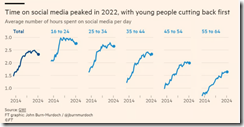Old Social Media Outfits May Be Vulnerable: Wrong Product, Wrong Time
October 30, 2025
 This essay is the work of a dumb dinobaby. No smart software required.
This essay is the work of a dumb dinobaby. No smart software required.
I read “Social Media Became Television. Gen Z Changed the Channel.” I liked the title. I liked the way data were used to support the assertion about young people. I don’t think the conclusion is accurate.
Let’s look at what the write up asserts.
First, I noted this statement:
Turns out, infinite video from people you don’t know has a name we already invented in 1950: Television.
I think this means that digital services are the “vast wasteland” that Newton Minnow identified this environment. I was 17 years old and a freshman in college. My parents acquired a TV set in 1956 when I was 12 years old. I vaguely remember that it sucked. My father watched the news. My mother did not pay any attention as far as I can recall. Not surprisingly I was not TV oriented, and I am not today.
The write up says:
For twenty years, tech companies optimized every platform toward the same end state. Student directories became feeds. Messaging apps became feeds. AI art tools became feeds. Podcasts moved to video. Newsletters added video. Everything flowed toward the same product: endless short videos recommended by machines.
I agree. But that is a consequence of shifting to digital media. Fast, easy, crispy information becomes “important.”
The write up says via a quote from an entity known as Jon Burn-Murdoch:
It has gone largely unnoticed that time spent on social media peaked in 2022 and has since gone into steady decline
That’s okay. I don’t know if the statement is true or false. This chart is presented to support the assertion:
The problem is that the downturn in the 16 to 24 graph looks like a dip but a dip from a high level of consumption. And what about the 11 to 15 year olds, what I call GenAI? Not on the radar.
This quote supports the assertion that content consumption has shifted from friends to anonymous sources:
Today, only a fraction of time spent on Meta’s services—7% on Instagram, 17% on Facebook—involves consuming content from online “friends” (“friend sharing”). A majority of time spent on both apps is watching videos, increasingly short-form videos that are “unconnected”—i.e., not from a friend or followed account—and recommended by AI-powered algorithms Meta developed as a direct competitive response to TikTok’s rise, which stalled Meta’s growth.
Okay, Meta has growth problems. I would add that Telegram has growth problems. The antics of the Googlers make clear that the firm has growth problems. I would argue that Microsoft has growth problems. Each of these outfits has run out of prospects. Lower birth rates, cost, and the fear-centric environment may have something to do with online behaviors.
My view is that social media and short videos are not going away. New services are going to emerge. Meta-era outfits are just experiencing what happened to the US steel industry when newer technology became available in lower-cost countries. The US auto industry is in a vulnerable position because of China’s manufacturing, labor cost, and regulatory environment.
The flow of digital information is not stopping. Those who lose the ability to think will find ways to pretend to be learning, having fun, and contributing to society. My concern is that what these young people think and actually do are likely to be more surprising than the magnetism of platforms a decade old, crafted for users who have moved on.
The buzzy services will be anchored in AI and probably feature mental health, personalized “chats,” and synthetic relationships. Yep, a version of a text chat or radio.
Stephen E Arnold, October x, 2025
Comments
Got something to say?



